Application Model for a Stirling Engine Micro-Generation System in Caravans in Different European Locations
Abstract
:1. Introduction
2. Materials and Methods
2.1. The Stirling Engine
2.1.1. Main Characteristics
2.1.2. Operating Principle
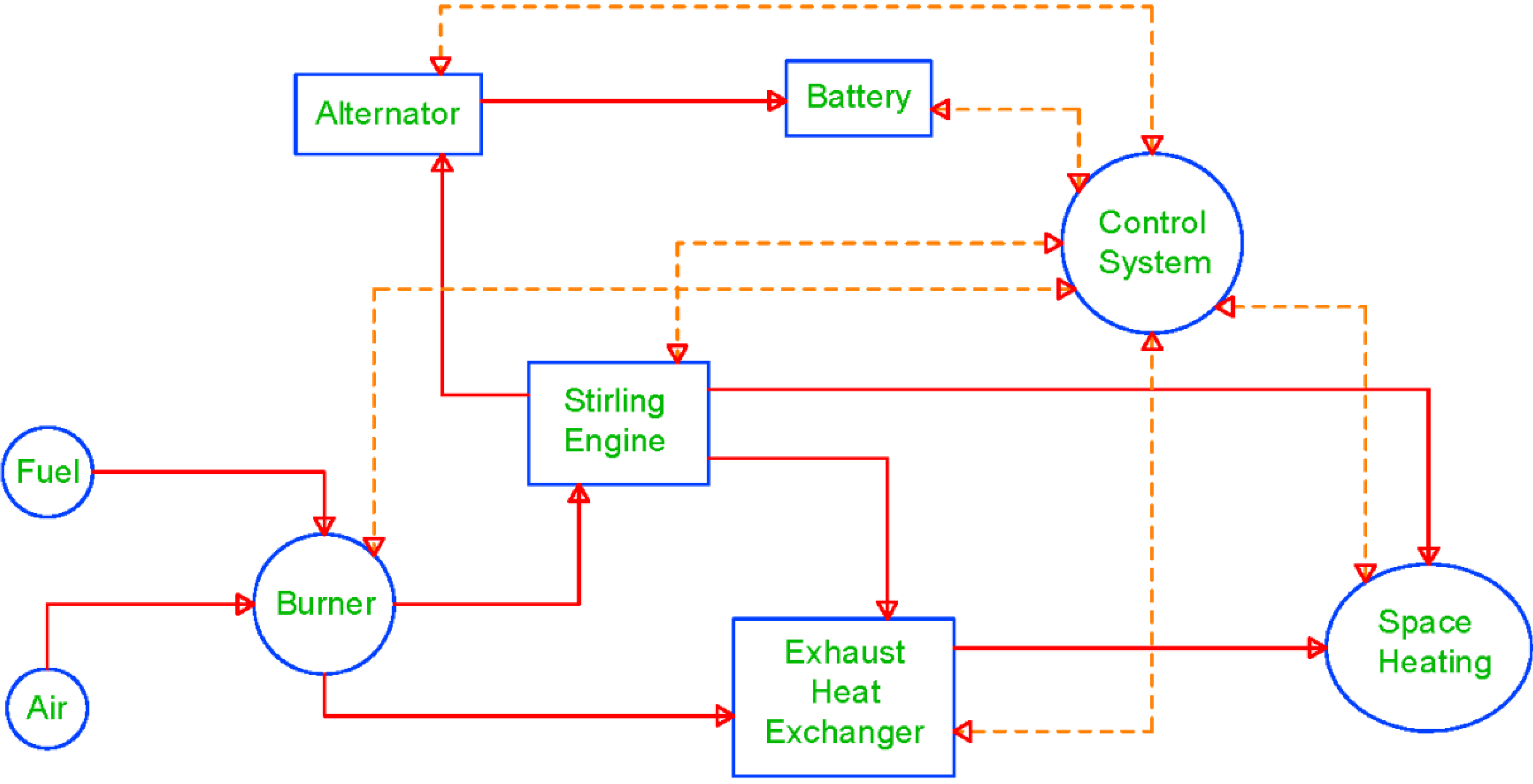
2.1.3. Running Modes
2.1.4. Experimental Procedure
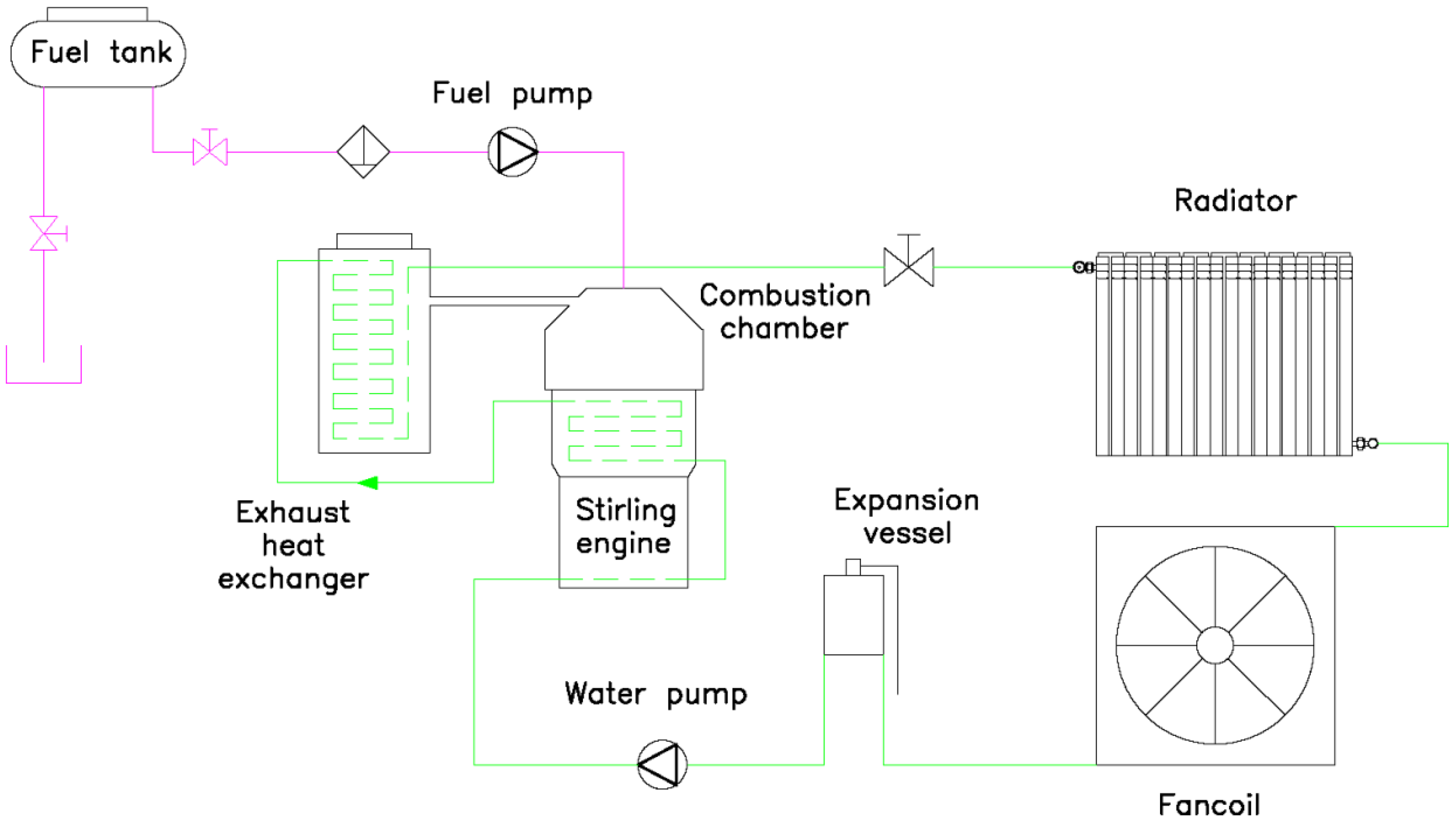
2.1.5. Experimental Results
| Test number | Electrical load (kW) | Electrical power (kW) | Thermal power (kW) | Consumption (kg/h) |
|---|---|---|---|---|
| 1 | 0.350 | 0.918 | 5.851 | 0.647 |
| 2 | 0.400 | 0.919 | 5.954 | 0.633 |
| 3 | 0.450 | 0.932 | 6.095 | 0.637 |
| 4 | 0.500 | 0.933 | 6.057 | 0.645 |
| 5 | 0.550 | 0.931 | 6.016 | 0.643 |
| 6 | 0.650 | 0.929 | 5.980 | 0.641 |
| 7 | 0.750 | 0.932 | 5.978 | 0.642 |
| 8 | 0.950 | 0.904 | 5.770 | 0.641 |
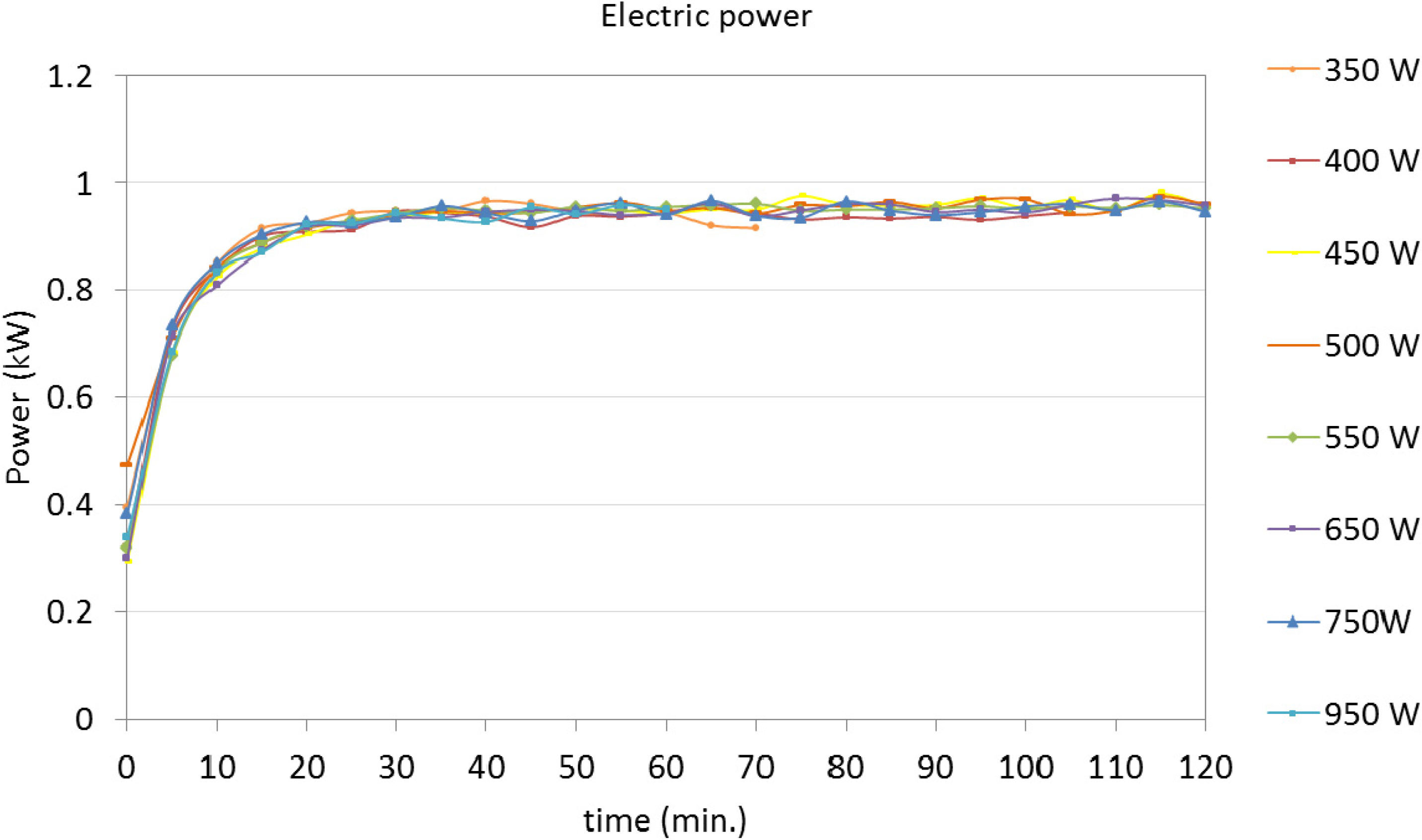
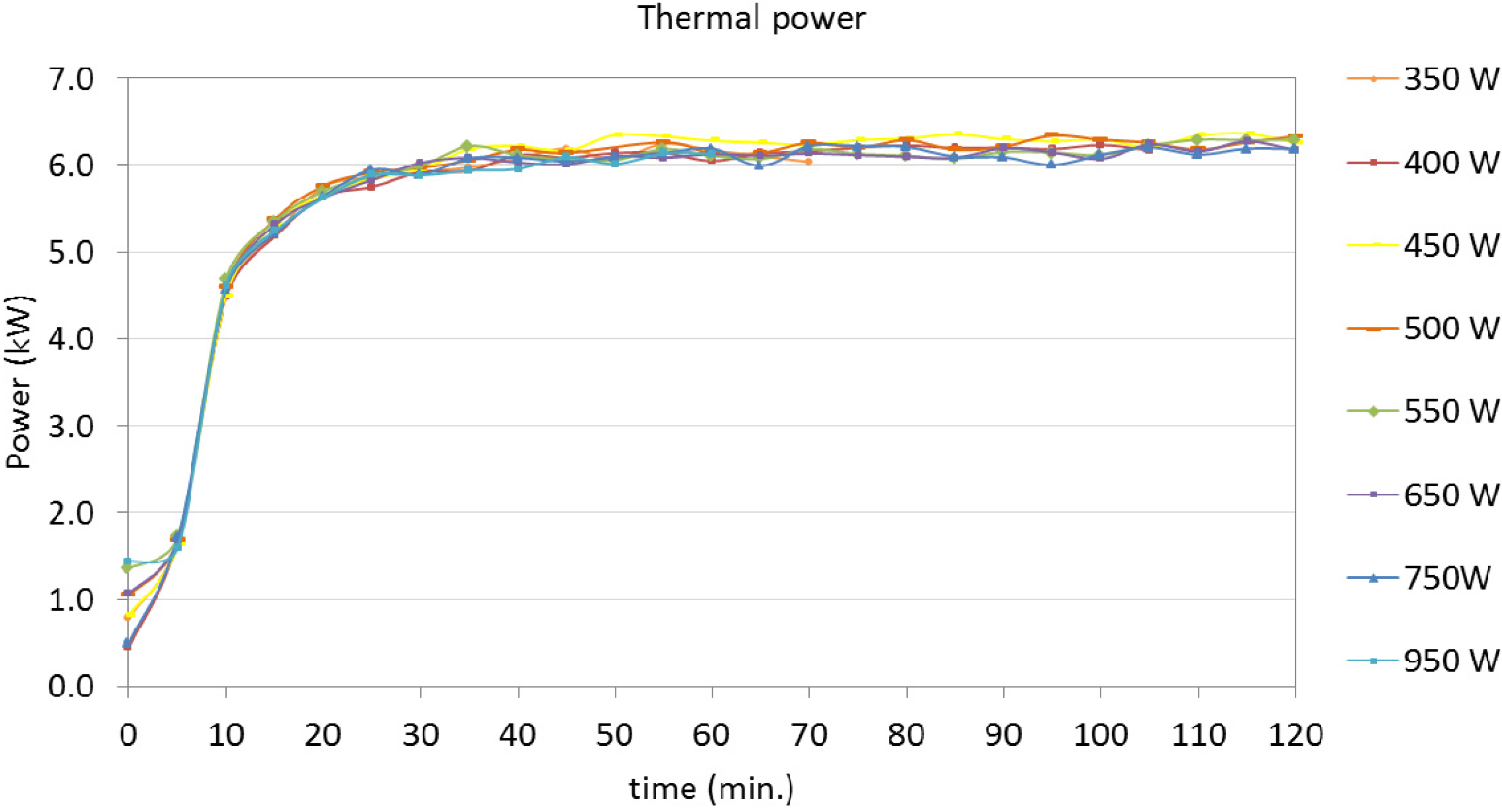
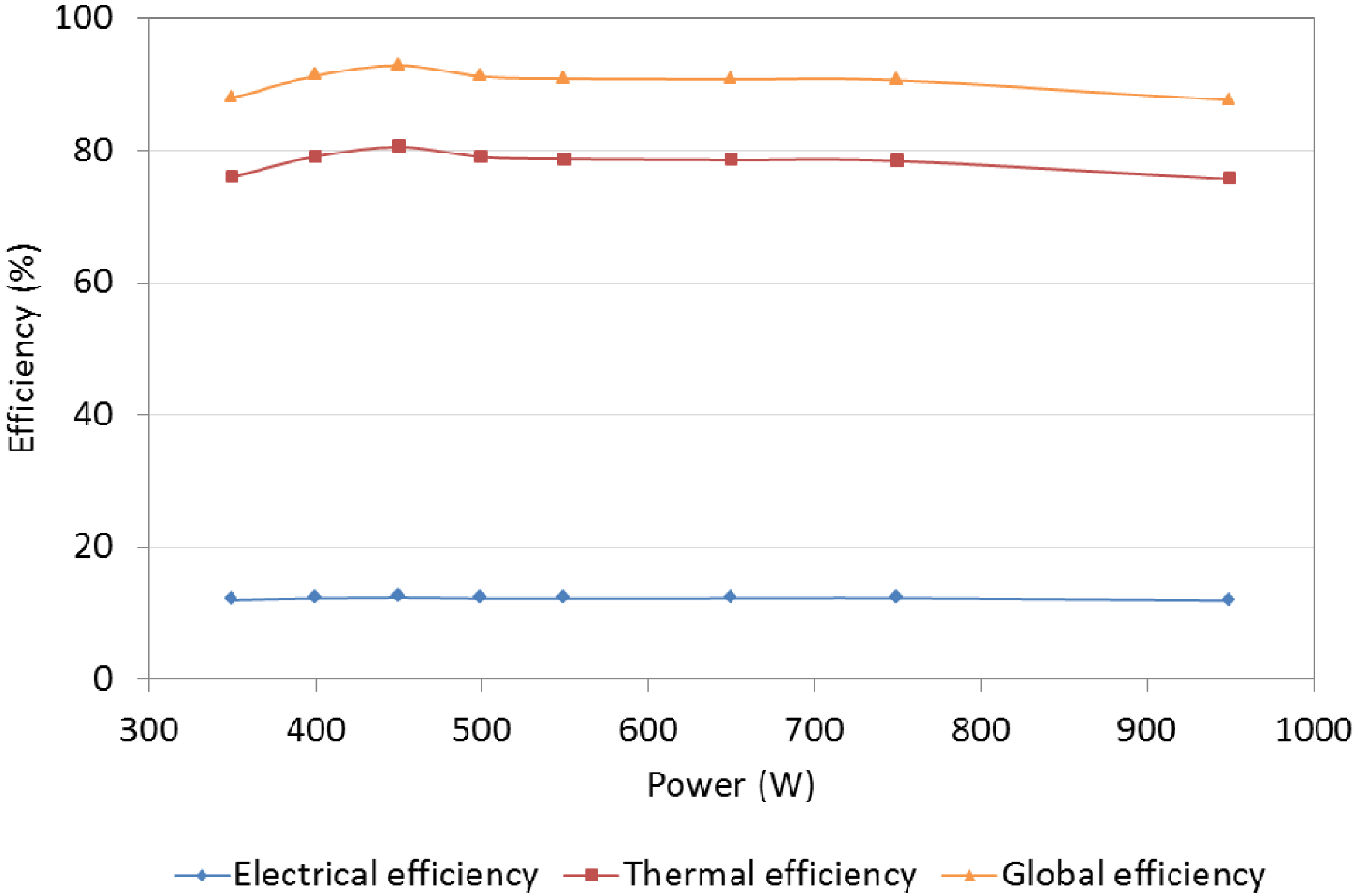
| Dimension/Properties | Outer aluminum layer | Insulation polyurethane | Inner Plywood layer |
|---|---|---|---|
| Thickness (mm) | 1 | 26 | 3 |
| Thermal Conductivity (W/m·K) | 160 | 0.034 | 0.17 |
| Dimension/Properties | Outer aluminum layer | Insulation polyurethane | Inner Plywood layer |
|---|---|---|---|
| Thickness (mm) | 4 | 30 | 6 |
| Thermal Conductivity (W/m·K) | 160 | 0.034 | 0.17 |
2.2. The Vehicle
2.2.1. Selected Vehicle and Main Characteristics
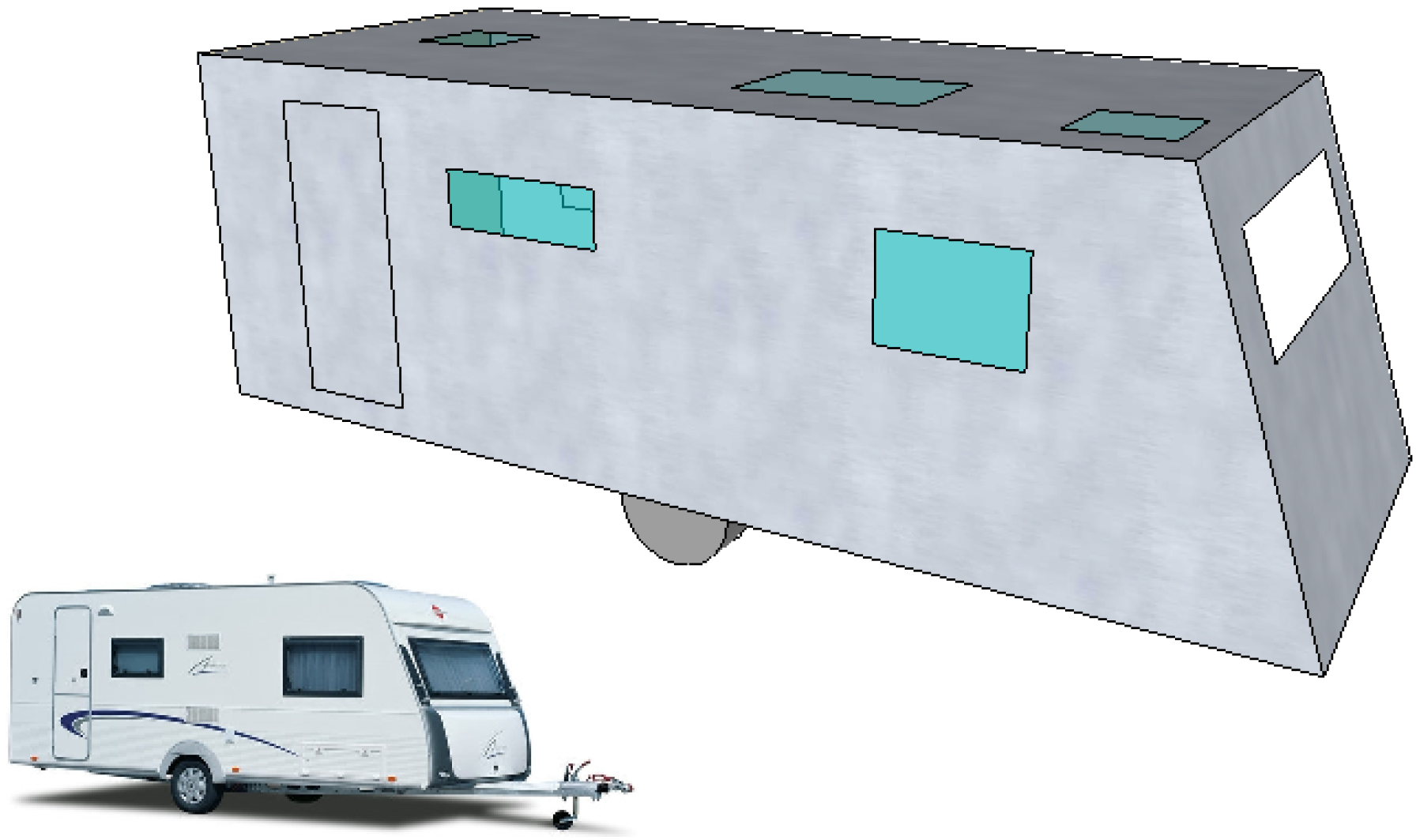
2.2.2. Structural Characteristics
2.2.3. Electrical Power Consumption
| Equipment | Consumption (kWh/month) | Utilization rate | Expected consumption (kWh/month) | Expected consumption (kWh/year) |
|---|---|---|---|---|
| Fridge THETFORD N145 | 120 | 25% | 30 | 360 |
| Lights (4 × 25 W) | 3 | 20% | 0.6 | 7.2 |
| Oven THETFORD DUPLEX | 45 | 2% | 0.9 | 10.8 |
| TV 20’’ + DVD | 3 | 4% | 0.12 | 1.44 |
| Total | 31.62 | 379.44 |
3. Simulation Process
- Infiltrations: one air change per hour with ambient conditions.
- Long-wave radiation exchange to the atmosphere: Assuming that the sky is an ideal black surface and taking into account the cloudiness factor of the sky, an effective sky temperature is determined as in [23].
- Convective Heat Transfer Coefficient of Walls: calculated as a function of air velocity, air temperature (Reynolds and Prandtl numbers) and the external temperatures of the walls (see Incropera and DeWitt [24]).
- The heat consumption associated with the generation of domestic hot water was not taken into account. This heat may increase the engine operation.
- The heat generation produced by two resting people has been taken into account as internal heat gains according to ISO 7730.
- The thermal behavior of the caravan walls has been modeled by transfer functions calculated by the TRNBUILD module.
- The simulation time step has been decreased to 1 minute for more accurate results.
- The SE was set to work with HMM on. In this mode, the SE attends to the thermal requirements of the caravan, and the cogeneration system will follow the heating demand.
4. Results and Discussion
4.1. Maximum Heat Load Analysis in Different European Locations
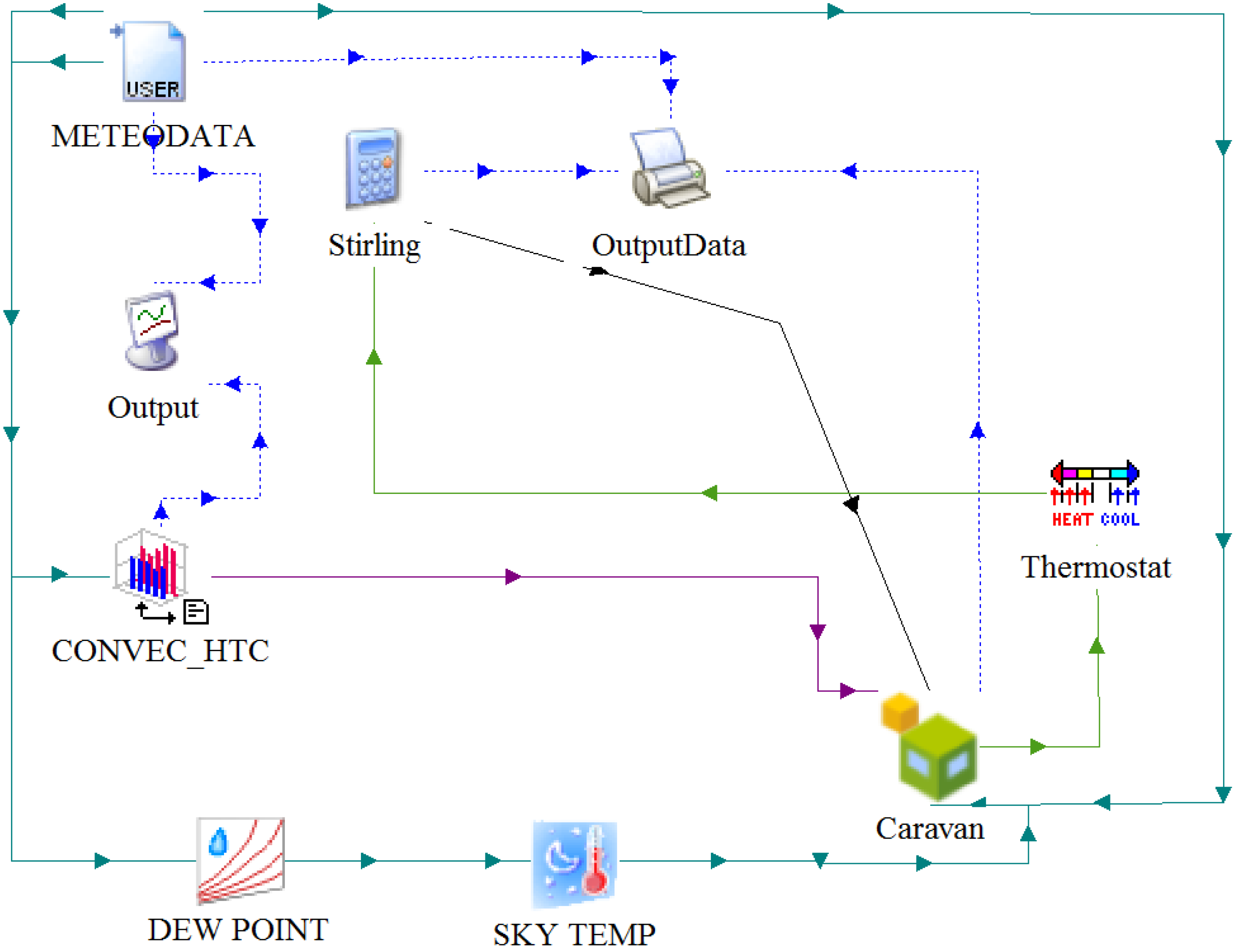
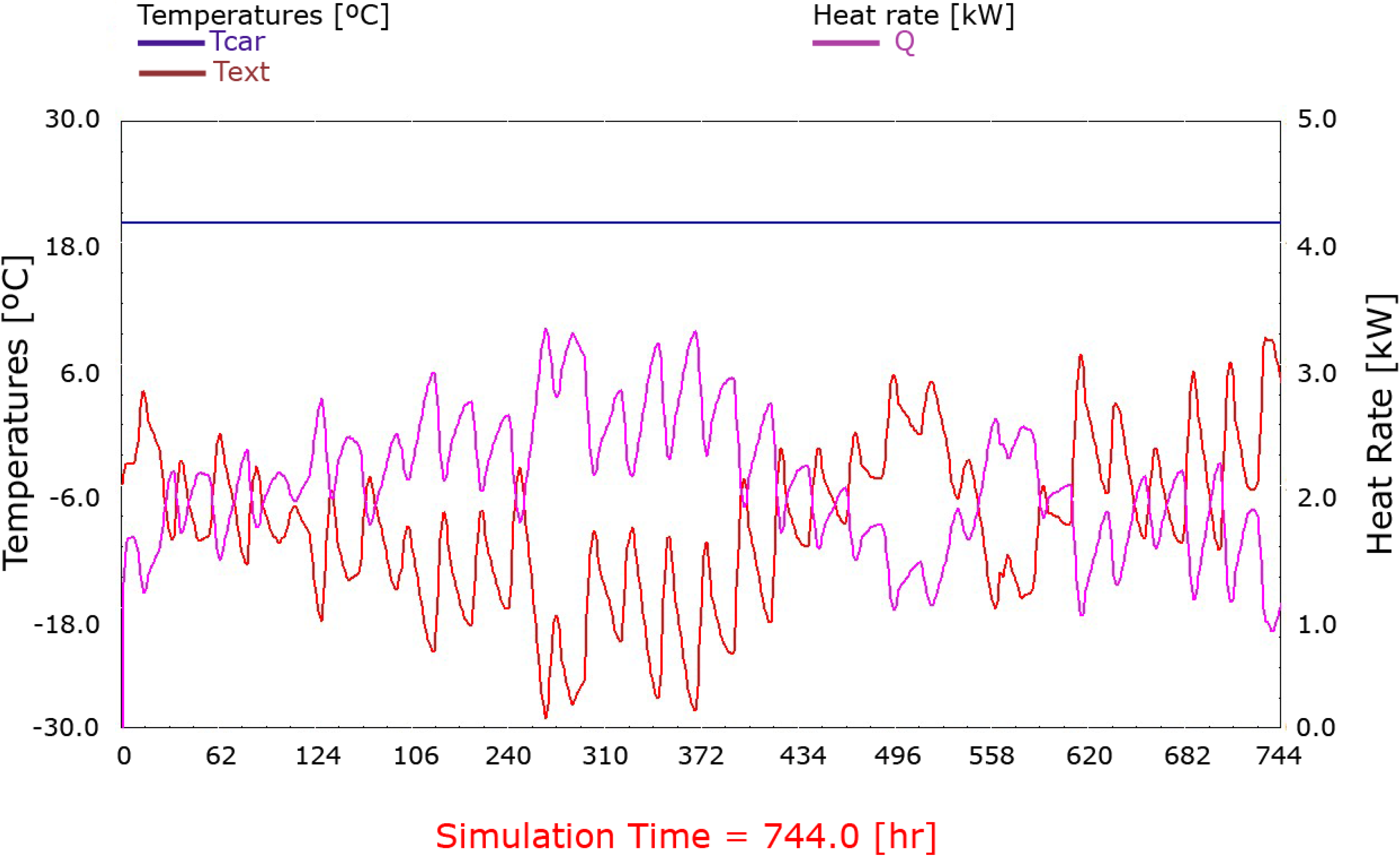
| City | Max. heating rate (kW) | Min. temperature (°C) | Day of max heating rate | Hour of max. heating rate |
|---|---|---|---|---|
| Seville | 1.22 | 2.8 | 12 January | 9 |
| Madrid | 1.70 | −4.9 | 25 December | 9 |
| Vigo | 1.32 | 0.1 | 25 January | 1 |
| Marseille | 1.56 | −2.3 | 13 January | 2 |
| Vienna | 1.99 | −9.8 | 15 January | 8 |
| Paris | 1.70 | −5.1 | 15 January | 9 |
| Brussels | 1.82 | −7.2 | 13 January | 0 |
| Berlin | 3.29 | −28.9 | 12 January | 8 |
| Copenhagen | 1.96 | −7.9 | 15 February | 1 |
| Helsinki | 2.81 | −21.9 | 15 February | 8 |
| Oslo | 2.30 | −13.9 | 14 February | 19 |
| Vilnius | 2.73 | −20.8 | 12 January | 19 |
| Athens | 1.42 | −0.3 | 15 February | 4 |
| Roma | 1.51 | −1.8 | 13 January | 7 |
| Dubrovnik | 1.36 | 0.2 | 15 February | 2 |
| London | 1.73 | −5.5 | 13 January | 1 |
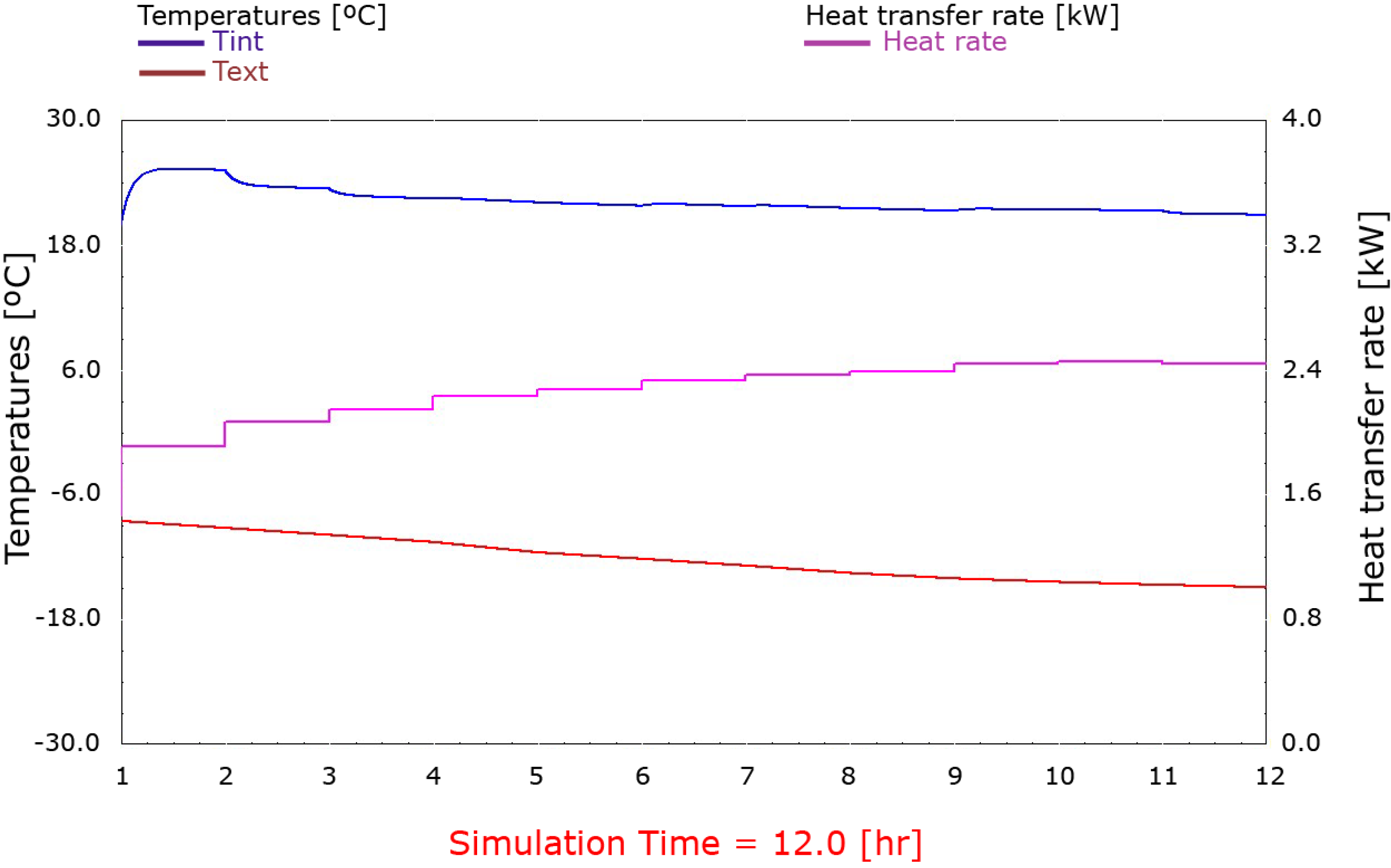
4.2. Discussion
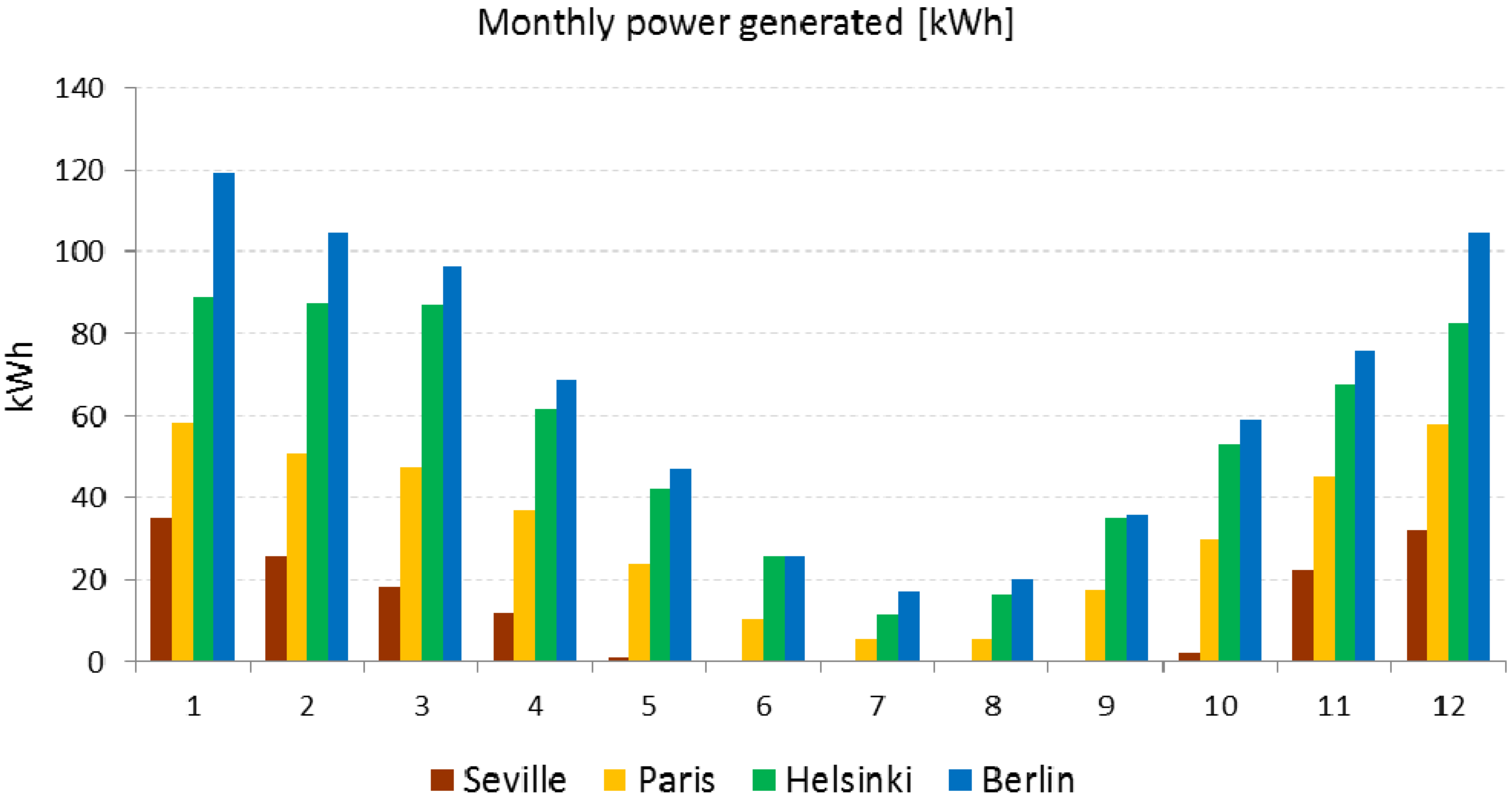
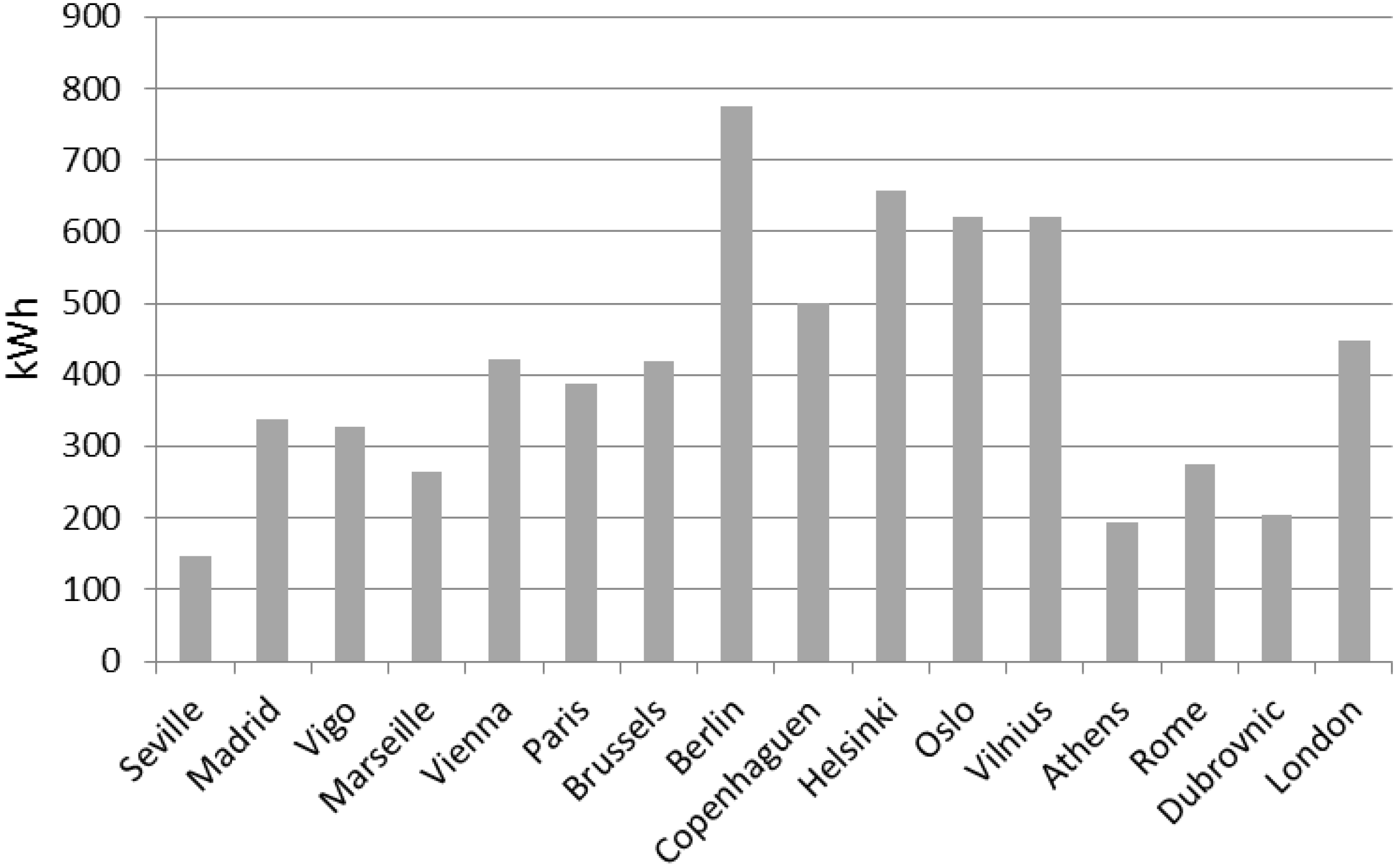
- The heat flux through the envelope can differ depending on where the caravan parks. The results would be different if the location is sheltered or in an open landscape.
- Some of commercial caravans use isolation materials inferior to the selected ones.
- The infiltrations are difficult to measure, and the assumed rate of one per hour may be well below reality, especially if the doors are repeatedly opened.
- A heat exchanger could be used to recover heat in vent conductions.
- Any electrical consumption results in a decrease of the thermal demand.
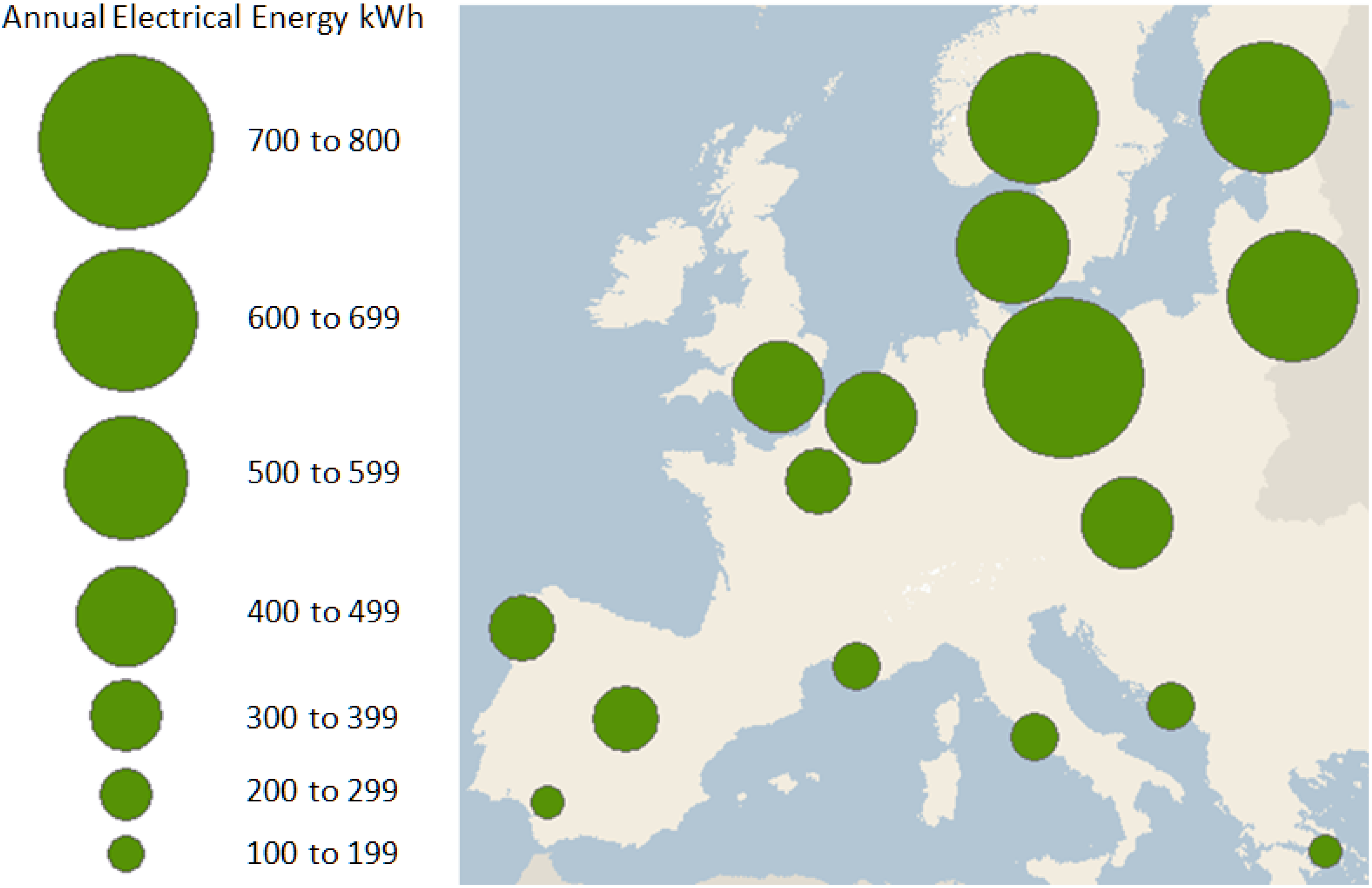
| City | Heating Energy (kWh) | Power Energy (kWh) | Fuel Consumption (kg) |
|---|---|---|---|
| Seville | 950.26 | 147.68 | 102.73 |
| Madrid | 2178.07 | 338.48 | 235.47 |
| Vigo | 2102.49 | 326.74 | 227.30 |
| Marseille | 1706.14 | 265.14 | 184.45 |
| Vienna | 2712.64 | 421.56 | 293.26 |
| Paris | 2495.38 | 387.80 | 269.77 |
| Brussels | 2693.50 | 418.58 | 291.19 |
| Berlin | 4981.98 | 774.23 | 538.59 |
| Copenhagen | 3223.34 | 500.92 | 348.47 |
| Helsinki | 4237.24 | 658.49 | 458.08 |
| Oslo | 3986.63 | 619.54 | 430.99 |
| Vilnius | 3996.39 | 621.06 | 432.04 |
| Athens | 1243.20 | 193.20 | 134.40 |
| Rome | 1765.44 | 274.36 | 190.86 |
| Dubrovnik | 1311.38 | 203.80 | 141.77 |
| London | 2885.70 | 448.45 | 311.97 |
5. Conclusions
References
- Alanne, K.; Söderholm, N.; Sirén, K.; Beausoleil-Morrison, I. Techno-economic assessment and optimization of Stirling engine micro-cogeneration systems in residential buildings. Energy Convers. Manag. 2010, 51, 2635–2646. [Google Scholar] [CrossRef]
- Thiers, S.; Aoun, B.; Peuportier, B. Experimental characterization, modeling and simulation of a wood pellet micro-combined heat and power unit used as a heat source for a residential building. Energy Build. 2010, 42, 896–903. [Google Scholar] [CrossRef]
- Feidt, M.; Costea, M. Energy and exergy analysis and optimization of combined heat and power systems. Comparison of various systems. Energies 2012, 5, 3701–3722. [Google Scholar] [CrossRef]
- Míguez, J.L.; Murillo, S.; Porteiro, J.; López, L.M. Feasebility of a new domestic CHP trigeneration with heat pump: I. Design and development. Appl. Therm. Eng. 2004, 24, 1409–1419. [Google Scholar] [CrossRef]
- Porteiro, J.; Míguez, J.L.; Murillo, S.; López, L.M. Feasebility of a new domestic CHP trigeneration with heat pump: II. Availability analysis. Appl. Therm. Eng. 2004, 24, 1421–1429. [Google Scholar] [CrossRef]
- De Paepe, M.; D’Herdt, P.; Mertens, D. Micro-CHP systems for residential applications. Energy Convers. Manag. 2006, 47, 3435–3446. [Google Scholar]
- Miccio, F. On the integration between fluidized bed and Stirling engine for micro-generation. Appl. Therm. Eng. 2013, 52, 46–53. [Google Scholar] [CrossRef]
- Kuosa, M.; Kaikko, J.; Koskelainen, L. The impact of heat exchanger fouling on the optimum operation and maintenance of the Stirling engine. Appl. Therm. Eng. 2007, 27, 1671–1676. [Google Scholar] [CrossRef]
- Lombardi, K.; Ugursal, V.I.; Beausoleil-Morrison, I. Proposed improvements to a model for characterizing the electrical and thermal energy performance of Stirling engine micro-cogeneration devices based upon experimental observations. Appl. Energy 2010, 87, 3271–3282. [Google Scholar] [CrossRef]
- Aliabadi, A.A.; Thomson, M.J.; Wallace, J.S.; Tzanetakis, T.; Lamont, W.; di Carlo, J. Efficiency and emissions measurement of a Stirling-engine-based residential microcogeneration system run on diesel and biodiesel. Energy Fuels 2009, 23, 1032–1039. [Google Scholar] [CrossRef]
- Thombare, D.G.; Verma, S.K. Technological development in the Stirling cycle engines. Renew. Sustain. Energy Rev. 2008, 12, 1–38. [Google Scholar] [CrossRef]
- Farra, N.; Tzanetakis, T.; Thomson, M.J. Experimental determination of the efficiency and emissions of a residential microcogeneration system based on a Stirling engine and fueled by diesel and ethanol. Energy Fuels 2012, 26, 889–900. [Google Scholar] [CrossRef]
- Magri, G.; di Perna, C.; Serenelli, G. Analysis of electric and thermal seasonal performances of a residential microchip unit. Appl. Therm. Eng. 2012, 36, 193–201. [Google Scholar] [CrossRef]
- European Caravan Federation Homepage. Available online: http://www.e-c-f.com/ (accessed on 15 August 2012).
- Cardinale, N.; Stefanizzi, P.; Rospi, G.; Augenti, V. Thermal performance of a mobile home with light envelope. Build. Simul. 2010, 3, 331–338. [Google Scholar] [CrossRef]
- Ferguson, A.; Kellyb, N.; Weberc, A.; Griffith, B. Modelling residential-scale combustion-based cogeneration in building simulation. J. Build. Perform. Simul. 2009, 2, 1–14. [Google Scholar] [CrossRef]
- TRNSYS. Transient Systems Simulation Homepage. Available online: http://www.trnsys.com (accessed on 1 September 2012).
- Kwiatkowski, J.; Woloszyn, M.; Roux, J.J. Influence of sorption isotherm hysteresis effect on indoor climate and energy demand for heating. Appl. Therm. Eng. 2011, 31, 1050–1057. [Google Scholar] [CrossRef]
- Ayompe, L.M.; Duffy, A.; McCormack, S.J.; Conlon, M. Validated TRNSYS model for forced circulation solar water heating systems with flat plate and heat pipe evacuated tube collectors. Appl. Therm. Eng. 2011, 31, 1536–1542. [Google Scholar] [CrossRef]
- Campos-Celador, A.; Pérez-Iribarren, E.; Sala, J.M.; Portillo-Valdés, L.A. Thermoeconomic analysis of a micro-CHP installation in a tertiary sector building through dynamic simulation. Energy 2012, 45, 228–236. [Google Scholar] [CrossRef]
- Meteonorm Homepage. Available online: http://meteonorm.com/ (accessed on 1 September 2012).
- Ebrahimpour, A.; Maerefat, M. A method for generation of typical meteorological year. Energy Convers. Manag. 2010, 51, 410–417. [Google Scholar] [CrossRef]
- Martin, M.; Berdahl, P. Characteristics of infrared sky radiation in the United States. Sol. Energy 1984, 33, 321–336. [Google Scholar] [CrossRef]
- Incropera, F.P.; DeWitt, D.P.; Bergman, T.L.; Lavine, A.S. Fundamentals of Heat and Mass Transfer, 6th ed.; Prentice Hall: Mexico DF, Mexico, 2002. [Google Scholar]
© 2013 by the authors; licensee MDPI, Basel, Switzerland. This article is an open access article distributed under the terms and conditions of the Creative Commons Attribution license (http://creativecommons.org/licenses/by/3.0/).
Share and Cite
Ulloa, C.; Porteiro, J.; Eguía, P.; Pousada-Carballo, J.M. Application Model for a Stirling Engine Micro-Generation System in Caravans in Different European Locations. Energies 2013, 6, 717-732. https://doi.org/10.3390/en6020717
Ulloa C, Porteiro J, Eguía P, Pousada-Carballo JM. Application Model for a Stirling Engine Micro-Generation System in Caravans in Different European Locations. Energies. 2013; 6(2):717-732. https://doi.org/10.3390/en6020717
Chicago/Turabian StyleUlloa, Carlos, Jacobo Porteiro, Pablo Eguía, and José M. Pousada-Carballo. 2013. "Application Model for a Stirling Engine Micro-Generation System in Caravans in Different European Locations" Energies 6, no. 2: 717-732. https://doi.org/10.3390/en6020717
APA StyleUlloa, C., Porteiro, J., Eguía, P., & Pousada-Carballo, J. M. (2013). Application Model for a Stirling Engine Micro-Generation System in Caravans in Different European Locations. Energies, 6(2), 717-732. https://doi.org/10.3390/en6020717




